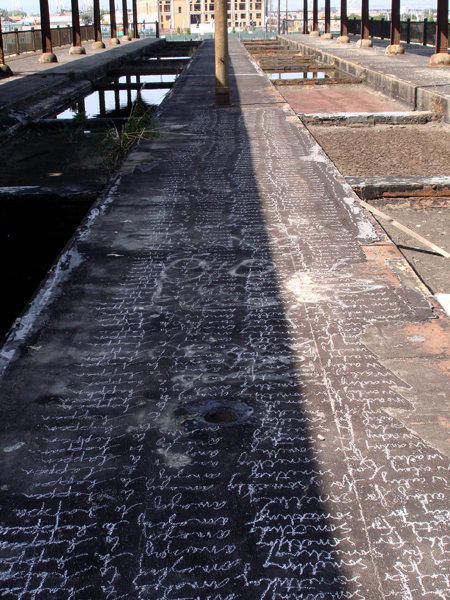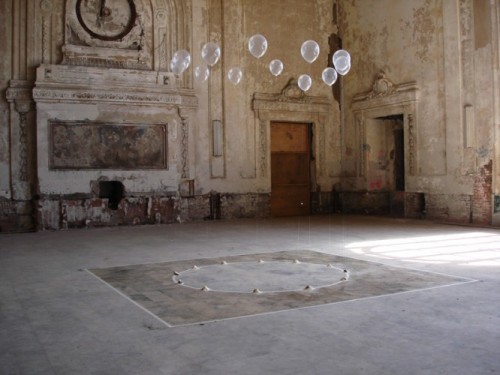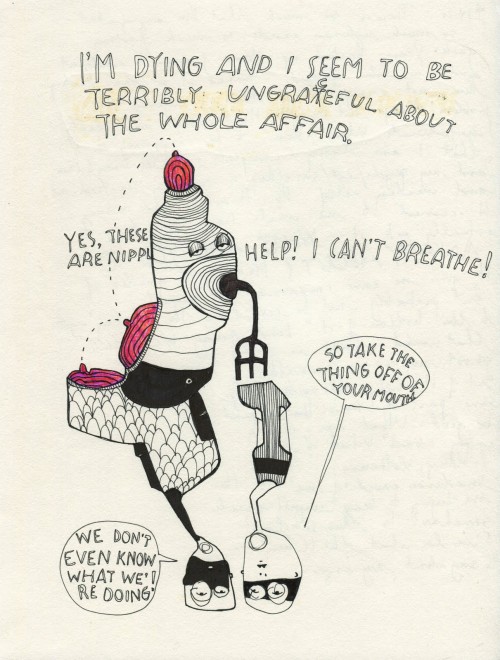
Jessica Serran. "Flip the Process," 2009. Mixed media on file folders. 73 x 73 inches. Courtesy the artist.
Jessica Serran is a Canadian-born artist currently living in Prague. Her drawings, paintings and installations incorporate images and words into surprising and often humorous gestalts. She creates these sensuous and conceptually challenging realms of connection in a wide variety of formats, from book illustrations to the floors and walls of decaying train stations.
Jason Lahman: How would you describe the relationship between the writing and the other sorts of visual forms that inhabit your pictures?
Jessica Serran: The two are really inseparable. Words have always been very visual for me. It’s how I learn a language and it’s how I gave myself headaches when I was a kid – I couldn’t “get the words out of my head.” Creating without words would be like creating without colors or lines for me. They’re part of my palette.
Words took on a much more prominent role when I started to pay attention to the constant internal dialogue that was there when I painted. It used to be debilitating because the words came from such a critical place. So I figured that if I were going to shift my relationship to the critic I would need to shift my relationship to the words. It became like a Buddhist meditation – noticing what was arising, noticing what nasty things the inner-critic had to say and then choosing to include it in the work.
As an end product, I’ve received a certain amount of criticism for the inclusion of words. Some feel that the visuals are stronger by themselves, and that the text causes an unfortunate break in how the images are read. But I like what the combination does – it creates a quality, and a particular way of reading and entering the work. It’s as if you’re zooming in under a microscope – giving the viewer/reader a chance to vacillate between two different ways of perceiving.
JL: Your images often blur the line between animate and inanimate things. What is at the heart of this sort of metamorphosis for you?
JS: There’s so much story to tell through a gesture, or an expression, or the way that a body holds itself. And objects have such expressive potential and stories of their own to tell. A chair with only three legs suggests something very different than a chair with all four legs planted firmly on the ground. By blurring these lines between human and object, and imagining how our felt experience of the world shapes us, I end up with these forms that exist somewhere between what we see around us and what we know a body or a piece of furniture to look like.
Using everyday objects helps to unravel the story of the body because we know what a chair is supposed to look like and we know how a body tends to look. By combining the two, or anthropomorphizing the objects, you get into this interesting territory where you’re not completely baffled because you have solid reference points, but you’re forced to reconsider what it means or why it doesn’t look the way you expect it to look.

Jessica Serran. "Dead Center," 2007. Mixed media on file folders. 82 x 74 inches. Courtesy the artist.
JL: Maps and mapping seem to be important motifs in your work.
JS: In many ways I’m mapping the ways things come together in my mind. Because my process is so automatic and intuitive, the best comparison that I can make is to being plopped in the middle of some dense wilderness. What unfolds on the canvas is an account of what I bump up against along the way, mixed with reverie for what it might mean and how it feels. I map the terrain as it’s being re-discovered and documented, before I get to the point where I’m able to stand on the mountaintop and properly survey the landscape below.
JL: I really like the humor in your drawings and paintings. How does keeping a sense of humor play a role in your work? What sorts of things make you laugh or do you find ironic?
JS: This question makes me laugh – mostly because I’m such an accidental comic when it comes to my work. I’m glad that people find the work funny but it’s been a surprising revelation. It makes sense, since I do love irony, that this appears in the work. I love it when people say the thing that they’re not supposed to say – and they know it. Humor that revolves around taboos and reveals that we might actually be more base and less politically correct than we claim to be. I get a kick from saying things that imply that I am capable of things that might at first glance seem outside the realm of my own character – trying to point out the places where I see my own fallacies and my own role in these grand meaning-making schemes that I concoct.

Jessica Serran. "I am waiting for something amazing to happen" (detail). Mixed media installation in West Oakland, CA train station. Courtesy the artist.
JL: When I spend time with your work I am reminded of a number of modernist techniques, like the Surrealist game exquisite corpse or Spiritualist automatic writing. How does your technique work with flow or inspiration or whatever you want to call it?
JS: In some ways I think I’m lucky – because my work is not dependent on that ever-elusive moment of inspiration. I don’t experience the proverbial creative block (knock on wood), because I’m not waiting for a spark. Instead, I try to work with exactly what’s showing up for me in any given moment. It means that there is always grist for the mill. It also takes a lot of pressure off.
It is very much in the vein of automatic writing and certainly studying in the Arts and Consciousness Department at JFK University in Berkeley helped open up pathways. I’m always curious about what lies beneath the surface, and about what we’re not saying or aware of and then figuring out how to access, and engage with that. I find that whenever I try to make a piece of art into something that I’ve decided it will be in advance, it loses its spark. So the work is more alive if I just get out of my own way and let whatever is there come through.

Jessica Serran. "I am waiting for something amazing to happen" (detail). Mixed media installation at West Oakland, CA train station. Courtesy the artist.
JL: Like you, I also studied art at the Center for Creative Studies in Detroit. How did living in Detroit impact you, your work and your process? How has Prague, your current city of residence, impacted you?
JS: Detroit, ah, yes…. It was a time of important discoveries and people. I remember fondly one of my favorite teachers at CCS telling me that when he went into his studio, he described himself as being like a “dumb f**king animal.” I loved that. He is also the one who introduced me to the work of Cy Twombly. I remember thinking to myself, “oh – a mark, a scribble – that can be enough.” Detroit is so textured. So raw. So honest. I always feel like I’m coming home when I cross the bridge from Windsor (Canada) to Detroit. I’ve also had great experiences showing my work there for the past eight years.
As for Prague, it is literally shaping my work since my current project is an investigation of this place and its people. Identity is broader and more historical there. Its history feels inescapable. This is showing up in my paintings as well – as spires and architectural references which are playing a part in a conversation that I’m having about gender, sexuality and the body. But I’m also interested in the question of how we get inside of a place when we can’t access it through its language? What is available to us then? How can we relate? It becomes more sensual in a lot of ways, and that’s showing up in my work.







